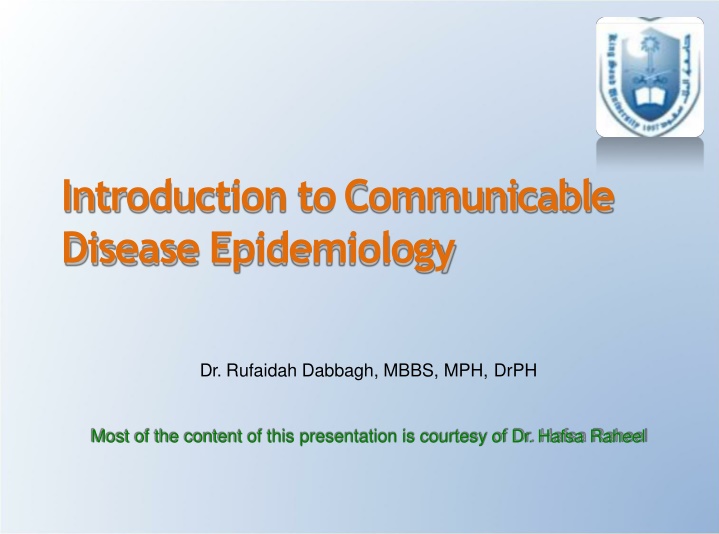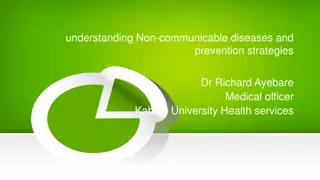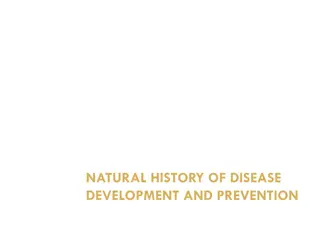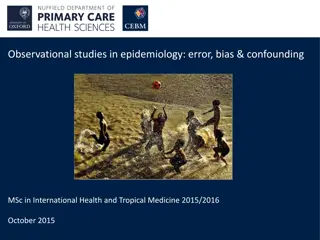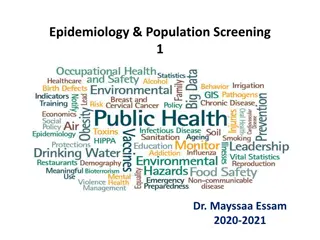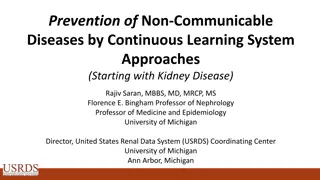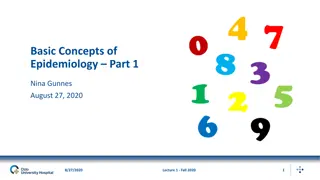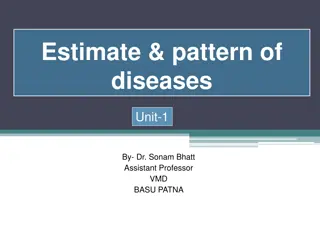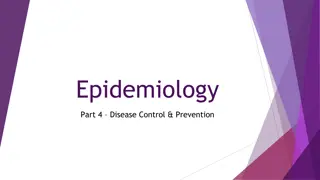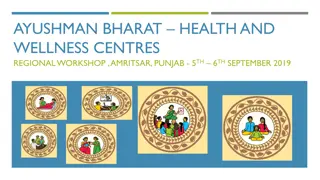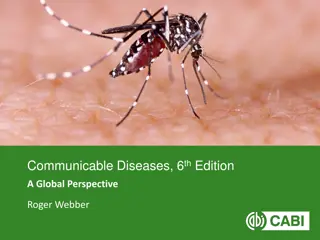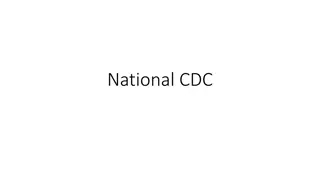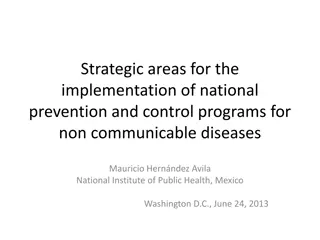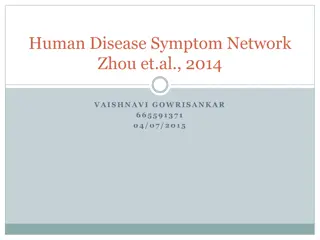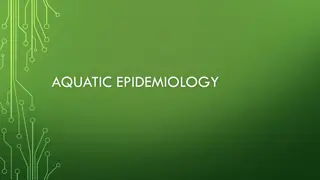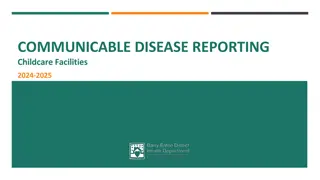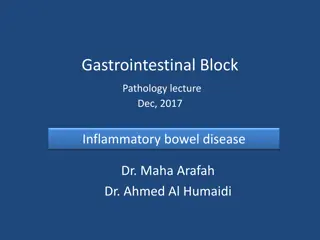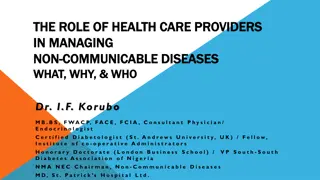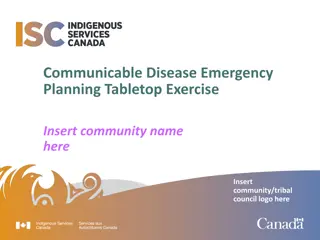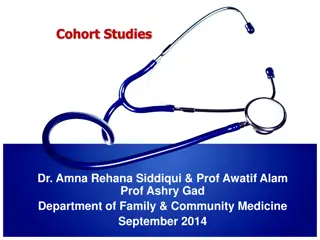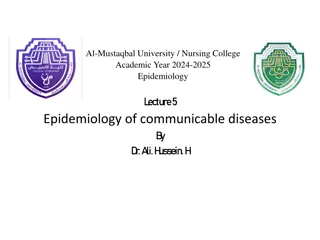Basics of Communicable Disease Epidemiology
This presentation covers a wide range of topics related to communicable disease epidemiology, including definitions, the cycle of infection, types of infectious agents, reservoirs of infection, modes of transmission, incubation period, immunity types, and prevention measures. Explore the fundamental concepts essential for understanding and controlling communicable diseases.
Download Presentation

Please find below an Image/Link to download the presentation.
The content on the website is provided AS IS for your information and personal use only. It may not be sold, licensed, or shared on other websites without obtaining consent from the author.If you encounter any issues during the download, it is possible that the publisher has removed the file from their server.
You are allowed to download the files provided on this website for personal or commercial use, subject to the condition that they are used lawfully. All files are the property of their respective owners.
The content on the website is provided AS IS for your information and personal use only. It may not be sold, licensed, or shared on other websites without obtaining consent from the author.
E N D
Presentation Transcript
Introduction to Communicable Disease Epidemiology Dr. Rufaidah Dabbagh, MBBS, MPH, DrPH Most of the content of this presentation is courtesy of Dr. Hafsa Raheel
By the end of this sessionstudents should be ableto Define communicable disease, control, elimination anderadication Draw the cycle of infection Give examples of different types of infectious agents associated withdiseases in humans List the types of reservoir ofinfection Classify carriers and to explain their public health importance indisease transmission Illustrate with examples the different modes oftransmission of communicable diseases Define incubation period Classify and differentiate between the types ofimmunity Outline the measures for the prevention and control ofcommunicable diseases
What is a CommunicableDisease? It is an illness caused by an infectious agent or its toxic product that is transmitted froman infected person, animal or inanimate source to a susceptiblehost Source: Heymann DL. Control of communicable diseases manual. 19th Edition. Washington DC, USA: American Public Health Association; 2008.746
EpidemiologicTriad Agent Vector Environment Host Source: Gordis L. Epidemiology. Fourth Edition. Philadelphia, PA: Elsevier Saunders, 2009
Cycle of Infection Portal of exit Types of agent -Virus Bacteria Parasite Reservoir Agent - - Susceptible Host Transmission Portal of entry
TheReservoir Itisthehabitatwheretheinfectiveagentsurvivesgrowsand multiplies in such a manner that it can be transmitted to a susceptiblehost. Reservoir of infection canbe: => case orcarrier Human Carrier=personwithunapparentinfectionthattransmitthediseasetoothers Animal => case orcarrier Environmentalreservoir: Water => e.g. legionnaire'sdisease Soil => e.g. Botulism,Tetanus, Combination of these types Plants
Chain of Infection Portal of exit Reservoir Agent Susceptible Host Transmission Portal of entry
TheAgent Mechanism of disease production(pathogenesis) ability of the organismsto invadethe tissues Invasiveness: andmultiply ability of the organismto produce toxins T oxigenicity: Exotoxins:(releasedbyliving organisms):Heatlabile; highly immunogenic and converted to antigen or toxoid by formalin, 1 heat andacid. Endotoxins: (released after disintegration of the organism): Heat stable, poorly immunogenic and not converted totoxoid. 2
TheAgent Pathogenicity: The power of an infectious agent to producedisease Virulence: Ability toproduce severe pathological reaction. Measured by the ratio of clinical to subclinical disease and case fatalityrate Dose of infection (inoculum): high probability of severe disease with higher dose of infection Viabilityoftheorganism(resistance):Ability of the organismto live outsidethe body Spore formation: Maintain viability for a long period in unfavorable environmentalconditions Antigenicpowerof theorganism:Ability to stimulate the immune systemto produce antibodies or antitoxin with subsequentimmunity. Measured by the secondattackfrequency Easeofcommunicabilityismeasuredbythe secondaryattackrate,which isthe number of secondary cases, occurring within the range of incubation period following exposure to a primary case expressed as a percentage of susceptible.
Chain of Infection Portal of exit Reservoir Agent Susceptible Host Transmission Portal of entry
The Mode ofTransmission IndirectTransmission 2. Direct Transmission 1. Airborne Direct contact droplet nuclei ordust suspended in air skin-to-skin e.g.STDs Vehicle food, water,biological products,fomites Dropletspread spray with dropletover Vector insects a few feet e.g.pertussis, may support growthor change to the agent
INCUBATIONPERIOD It is the period between the entry of the organismandthe appearanceof the first symptomof the disease Knowledge of the incubation period is importantfor Surveillance and quarantine in somediseases Application of preventivemeasuresto abort or modify the attack. Identification of the source ofinfection
Chain of Infection Portal of exit Reservoir Agent Susceptible Host Transmission Portal of entry
The Portal of Entry andExit Portalofentry: it isthepathbywhichthe infectious agent enters thathost Portal of exit: is the path by whichthe infectious agent exits the infectedhost These could be: Skin => Direct contact; e.g. scabies, fungal, staph Mucous membrane => e.g. HBV, STDs Respiratory tract => rhinovirus, EBV GIT => E-coli, enteric virus, HAV GUT => gonorrhoea, syphilis .. Blood => HIV, HCV, HBV, malaria
Chain of Infection Portal of exit Reservoir Agent Susceptible Host Transmission Portal of entry
TheHost A host is a person or other living animal, thataffords living conditions suitable for the growth of aninfectiousagent Susceptibility to infection isuniversalbut susceptibilityto disease dependson: Immunity 1 2 Dietary and nutritionalfactors 3-Geneticfactors
Immunity Types of Immunity Natural Acquired Natural resistance of thebody offered by skin, mucous membranes, gastric acidity, respiratorycilia Passive: acquired through transferred antibodies from mother to infant (natural) or by administration of immunoglobulin or anti-sera (artificial) Active: post infection immunity (natural) or following vaccination (artificial)
Pre-requisites for transmission ofa communicabledisease The six pre-requisites for the transmission ofcommunicable diseasesare 1. Presence of reservoir forinfection 2. Presence of microbiologicalagent 3. Portalof exit through which the microbiologicalagent leaves the reservoir 4. Mode oftransmission 5. Portalof entry (inlet) through which the microbiological enters thehost 6. Presence of susceptiblehost
Prevention and Controlof CommunicableDiseases
We need to break the cycle Portal of exit Reservoir Agent Susceptible Host Transmission Portal of entry
SomeDefinitions Control Activitiesconducted to bringadiseaseor ahealth problemata verylow leveltill it becomesnolonger apublic health problem Elimination Termination of all modesof transmissionto areduction of the incidence of the disease to the zero in a confined or specific geographic locality as a result of deliberate efforts yet, continued intervention methods arerequired Eradication Termination of all modesof transmissionof infection by extermination of the infectiousagent
Prevention and ControlMeasures Applied to Break DifferentStages of the InfectionChain
Measures That Directed to theAgent Sterilization Disinfection Proper treatment of infected individualsto kill the agent at itssource
Measures Directed to theReservoir Cases:Casefinding,reportingto thelocalhealthauthority inorderto apply the appropriate controlmeasuresforcontactandthe environment, isolation (strict isolation or discharge/body fluid isolation) for the whole period of communicability and treatment, surveillance for the longest incubation period. Carriers: Identification of carriers in the community, treatment and exclusionfrom worktill the organismiseliminatedespecially if foodhandlers orworkingwith children. Itscosteffectivenessdependsonthe proportionof carrierin the communityaswell asthe sensitivity of their occupation. Animal reservoir:Adequateanimalhusbandry,immunization of animals(if vaccineisavailable),treatment of infected animals andkilling if treatment is not feasible.
Measures Directed towardsBreaking Transmission Isolation if indicated =>to interrupt direct transmission Decontaminating of fomites => vehicletransmission Promote handwashing => prevent feco-oraltransmission Modify ventilation and air pressure => preventairborne transmission Control vector population => control vector-bornetransmission Environment:sanitation of water, food, proper sewagehandling
Measures Directedtowards Protecting Portal ofEntry Usingbed-nets Wearing masks and gowns to prevent entryof infected body secretions or droplets through skin or mucousmembranes Covering skin and using insectrepellents
Measures Directed tothe Host Healtheducation Adequate personalhygiene Soundnutrition Immunization Chemoprophylaxis
What is the Benefit of Complete Immunization in theCommunity? Complete immunization coverage can help prevent theagent from reaching a susceptiblehost Herdimmunity State of immunity withinthe community If a high proportion of individuals in the community are resistantto anagent,then susceptiblepeople will alsobe protected by the resistantmajority The level of susceptibility increases as new infants areborn, an epidemic will develop after accumulation ofsusceptible Itcouldbeproducedartificiallybyimmunization,ornaturally after infection
Exercise onMERS-Cov Middle Eastern Respiratory Syndrome Coronavirus(MERS-Cov) was first reported in Saudi Arabia in2012 In addition to humans, camels have also beeninfected People present with cough, fever and shortness ofbreath incubation period is from 2 to14 days Although not fully understood, it has been reported to spread from person-to-person through respiratory secretions,through close contact by care-giving and also in the hospital settingand possibly by contact with infectedcamels There is currently no available antiviral treatment orvaccine for MERS-Cov, thus general health precautions are advised when dealing with sickpeople
Exercise onMERS-Cov Reservoir: Portal of Exit: Mode oftransmission: Portal of entry: Incubation period: Prevention and controlmeasures: Factors in host -Factors related toagent -Factors related toreservoir Factors in environment
References Heymann DL. Control of communicable diseases manual. 19thEdition. Washington DC, USA: American Public Health Association; 2008.746 Gordis L. Epidemiology. Fourth Edition. Philadelphia, PA: Elsevier Saunders, 2009 Centers for Disease Control and Prevention. Introduction to Epidemiology- Section 10: Chain of Infection. 2012. Retrieved from: https://www.cdc.gov/ophss/csels/dsepd/ss1978/lesson1/section10.html. Accessed19.9.2017. Centers for Disease Control and Prevention. Information about MiddleEastern Respiratory Syndrome (MERS). 2015. Available at: https://www.cdc.gov/coronavirus/mers/downloads/factsheet-mers_en.pdf. Accessed:19.9.2017
